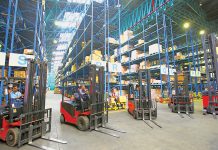COVID-19 magnified the shortage of infrastructure and assets within the supply chain industry leaving restructuring the only viable solution to counter challenges. With optimization of processes based on demand and supply, industry will be equipped to deal with the pandemic and future-proof its operations. CARGOTALK dwells further into details.
Priyanshi Bana
The pandemic has posed significant challenges for supply chains globally. Multiple national lockdowns continued to pose challenges in the smooth flow of raw materials and finished goods, disrupting manufacturing as a result. Many organizations suffered staff shortages and losses due to COVID-19. But overall, it has only magnified problems that already existed in the supply chain. Going by the present circumstances, the sector is under relentless pressure to continuously improve its supply chain performance so as to minimize cost and maintain high levels of customer service. Earlier, the companies reaped-in substantial benefits by working on initiatives involving supply chain integration and supply chain optimization. These initiatives have helped in ensuring above-average business performance in respective industry sectors. In the past few years, specifically in the last two years, leading firms have realized that initiatives involving supply chain integration and supply chain optimization are not enough for ensuring above-average business performance. These initiatives are necessary for the very survival.
Says Kartik Shah, CEO, Coldrush Logistics, “Supply chain restructuring involves several steps. To begin with, we must define the programme scope while simultaneously taking care of make versus buy decisions. Similarly, we should also consider other critical factors such as cost, competency, core/non-core, and future constraints during the restructuring process. We must monitor new policies and macroeconomic factors that drive sourcing and other supply chain decisions owing to their impact on the restructuring process. Integration of new products, production operations, logistics, and distribution is critical to ensure seamless transformation. This process mainly includes integrating IT and accounting systems, people coordination, and providing a cultural fit.”
He added, “Given the rapid digital adoption across industries, we firmly believe that tech integration will play a pivotal role in enhancing the operational ability of the logistics sector. Implementing Artificial Intelligence to build future prediction models is the need of the hour, and this will help the sector prepare for future uncertainties and serve clients more seamlessly with cost-effectiveness. We should also note that cost inflation, especially in outsourced products and services, has a massive impact on the overall restructuring program. Hence, we must also consider the probable process and raw material costs while designing the programme and keep in mind the need for additional resources, planning costs, and costs associated with unknown risks. For all restructuring projects, it is essential to plan and execute phase-in & phase-out of facilities to avoid delayed closure which usually happens due to ramp-up issues and the ability to maintain a stable workforce at the closing facilities. It is also crucial to have a burn-off plan for inventory, especially for supply chains with long lead times. Sometimes, this process calls for scrapping specific inventory, and in other cases, you might have to reschedule the transition dates. Last but not the least, capital investment and budget allocation are crucial for inventory to ensure a smooth transition of products from one facility to another. Transformation inventory requires budget allocation for capital costs. Hence, efficient inventory planning is a must to ensure uninterrupted supply during the transition phase. It is also vital to design an agile strategy which is responsive to changes across all levels. Transformation inventory is based on product development at the new facility, exit date for the current facility, and demand during the transition time. Given the volatile nature of the restructuring process, the companies must stay prepared with a flexible and responsive inventory planning process.”
Expounding on similar lines, Vivek Saxena, Head, Contract Logistics, India & ISC, Ceva Logistics, “For CEVA Logistics in India, we see many of our customers have started working on re-aligning their supply chains in advance, as they were already facing headwinds on the supply side. The post-pandemic customers have started restructuring their supply chain networks from different sourcing points to going as close as possible to where their customers are. So, from the customer’s perspective, we need to look at their sourcing points and their end customers, while creating an optimal solution for them based on our services in global air, ocean and land transportation, contract logistics, cross border or value-added services. The ultimate objective is to keep the customer’s supply chain agile and competitive in today’s dynamic market situations.”
According to Rajesh Makkolath, Associate Vice President and Head of Business Development, Godrej Storage Solutions says, “The pandemic has impacted the warehouse sector drastically. It has shown that businesses require more flexibility and agility to operate seamlessly in changing market conditions where automation comes into the picture. Smart warehousing enabled by automation helps in systematic logistics and supply chain management ensuring timely delivery of goods. With the radical increase in demand for warehouse usage, storage system facilities have adapted to the growing needs to provide dynamic services to various sectors. Although restructuring plans vary by industry, many companies are thinking about bringing manufacturing closer to demand.”
The supply chain integration and related practices have received adequate attention in the industry. People in the industry have realized that to stay in competition, they will have to go beyond these initiatives and look at ways in which they can restructure supply chain architecture and processes. Unlike supply chain integration and optimization, supply chain restructuring goes beyond and requires integrating product and process engineering with supply chain function. Similarly, it may also involve closer integration between marketing and supply chain function. According to Makkolath, “The potential of AI to optimize crucial processes such as restructuring, and management of the supply chain is revolutionising the industry. Smart warehousing, enabled by automation, provides clients with more efficiency by utilising these modern logistics centres. At Godrej Storage Solutions, we have designed modules for the industry around operations, safety and have specialised service offerings around audit and building capabilities. In large cases with complex operations, our handing over process includes providing training to the user group for better and improved usage and operations of the system.”
Adding to this, Swarup Bose, Founder and CEO, Celcius said, “Supply chain restructuring is a large-scale transformation programme and integration and optimization are steps within the programme, largely implemented in the post-close stage. The post-close stage of supply chain restructuring curtails stabilization, integration, and optimisation processes. Stabilization involves maintaining business continuity by monitoring performance and adhering to regulatory compliance. Once the newly acquired assets are incorporated into the existing operations, the synergy benefits become more apparent and this translates into the integration stage of supply chain restructuring. Finally, optimization involves design, planning and execution, thereby realizing complete synergy potential through supply chain integration and improvements that support both operational and commercial objectives of the restructuring programme.”
Explaining further, Saxena adds, “A global supply chain comprises sourcing, transportation and distribution components, so infrastructure and specific trade policies play vital roles for its performance. The changes in supply chain restructuring will yield better performance when the entire infrastructure and trade policies are aligned. At CEVA, we are assisting our customers in various ways by providing them infrastructure needed to make these changes in their supply chain networks, such as in transportation, warehouse storage sites, pickup and deliveries and numerous value-added services, allowing them to be closer to their customers and sourcing points in India and other global locations.
In addition, with 3PL and even 4PL services, we are helping our customers understand the market landscape and solving their challenges by making suggestions to streamline their supply chain networks. These modernized networks work more efficiently and remain agile to adjust to the dynamic supply chain scenarios. In India, we are one of the leading logistics service providers for some of the top companies in their respective fields and we are further strengthening our capabilities to help our customers for their sourcing, supply chain or distribution needs.”
However, there are certain challenges in its execution. Use of analytical tools, AI, Internet of Things in short, a robust digital network is required by the supply chains to be restructured in order to reach out to its customers swiftly. Bose said, “Restructuring calls for implementation of new systems and processes to maximise the output. This comes with a set of challenges which can be overcome with systematic and strategic planning and implementation. With technological advancements, most restructuring programmes can be carried out efficiently with little to no roadblocks. However, some general aspects within the programme such as phasing-in and phasing-out of facilities, reducing waste during transformation, and integration and optimization of the new systems, have to be monitored regularly to ensure that all hiccups can be dealt with effectively.”
Naveen Rawat, Co-Founder, Holisol Logistics, said, “Any supply chain restructuring initiative is a massive exercise and it involves sophisticated data analysis and planning. It is a complex decision process involving trade off in terms of cost, quality, delivery, and market access. The challenge is to be able to produce a dynamic agile supply chain that can efficiently and effectively mould as per the constantly changing business dynamics. Supply chains were undergoing fundamental and accelerated restructuring to respond to changing business dynamics and COVID-19 has accelerated the trend. The disruption to the flow of goods and services during the twin lockdowns has brought into focus the need to restructure supply chain to de-risk and strengthen resilience. The pandemic has resulted in a major shift towards D2C fulfilment which has required companies to restructure their supply chains also towards hyper local distribution compared to the prevailing regional distribution structure earlier. Pandemic has also forced companies to have a relook at their international supply chain focussing on restructuring opportunities in terms of near shoring or parallel sourcing.”
Highlighting the challenges further, Vijay Vashisht, Associate Vice President, Business, Safexpress said, “What we have today is incredibly complicated, complex global supply chains which have been so designed for the purpose of cost and efficiency. What are perhaps never factored in are the hidden dangers entailed in such models – what if something goes wrong along the way. And this is where the first challenge is entailed from – for a supply chain to be resilient, it has to do away with excessive complexity, the foundation of which is cost and efficiency. This is where the rub lies. Competition will ensure that manufacturer do not start transferring the cost of diversifying on the consumers.”
He added, “In addition, the pressure to operate efficiently and least possible capex would remain unrelenting. So, how to minimize the risks of disruption would require narrowing down the areas of risks and vulnerabilities at each level of supply chain including the diversity of suppliers, production centres and their geographical interconnectedness, transportation hubs, and distribution facilities. Second most obvious challenge to a resilient supply chain emanates from an ignorant push for an autonomous unit which is being increasingly manifested in the trade disputes, barriers and tariffs as visible in transnational trading. So, apart from an attitudinal change with somewhat contained ad reduced leitmotif of profit, what will be required is an attitudinal change at the level of policy-making.”
According to Saxena, “In today’s dynamic and rapidly changing market, we have seen disruptions and inconsistency in supply and demand across multiple global points, which creates challenges in deciding the best possible network or solutions for customers supply chain. In the global perspective, we see equipment shortages, capacity challenges, increasing rates, shutdowns due to the pandemic — all leading to the volatility in the current supply chain scenario. These inconsistencies and the unpredictability also mean that what constitutes a well performing supply chain network today, may not be viable tomorrow due to such frequent changes in geopolitical situation, tariffs, policies and market conditions.”
But, did the need of restructuring of supply arise due to the pandemic? Well, a few agree to this. According to Shah, “The world is increasingly going digital with tech integration in almost all sectors. The use of analytical tools and AI has changed the way we operate and look at business needs. At Coldrush Logistics, AI implementation is already a work in progress. With our industry experience and expertise in data analytical tools, we are confident to support the industry and cater to its requirements. So, restructuring is a necessity today, to reduce the overall cost of operations. We can surely achieve this goal by integrating data analytics and also building alliances with local players.”
Adding to this, Bose explained, “COVIOD-19 magnified the shortage of infrastructure and assets within the supply chain industry. Most supply chain entities were faced with shipping container shortages, congested ports, delays in receiving components, and the scarcity of truck drivers and other critical supply chain personnel. The cold supply chain industry was also faced with refrigerated vehicle scarcity and technological adoption to adhere to stringent vaccine transportation protocols. In times like these, restructuring is a viable solution to counter most challenges. With more assets on board and optimizing processes based on demand and supply, the industry will be better equipped to deal with the COVID-19’s volatile nature and future-proof its operations.”
Vashisht added, “Shocks in supply chain, first with supply shock, which originated in China, followed by demand shock are becoming more and more frequent and common. So even though each time there is a disaster, it seems like it is coming out of the blue. The fact is that the world is raging with such shocks in different corners of the globe frequently. Numbers of such calamities could be in hundreds during the last 2 decades. What the pandemic highlighted is the impact that the shocks can have on global supply chains — it has had a huge impact not just on the ability to get supply from suppliers sitting in different countries around the world, but also what has been happening with the end consumers in the value chains sitting in different corners in the world.”
This reflects the fact that we live in a multipolar economic system in which different economies are, while being interdependent, are also competing with each other. This has not happened since the world started becoming global and, in a way, this can be attributed to the pandemic, he averred.
Agreeing, Saxena said, “Yes, it is the need of the hour and necessary to make the preparations for the time to come. Agile supply chains are the future and we are working closely with customers as they implement lessons learnt during the pandemic. They have started diversifying their production capabilities in multiple geographies to have minimum supply chain disruptions in case of any such occurrence in the near future. Accessibility to markets is another factor which is driving companies to consider new sourcing points in global locations. They have also started to adjust the product mix, discussing about bringing in global products that can be sold across geographies to minimize the impact on their supply chains in future.”















